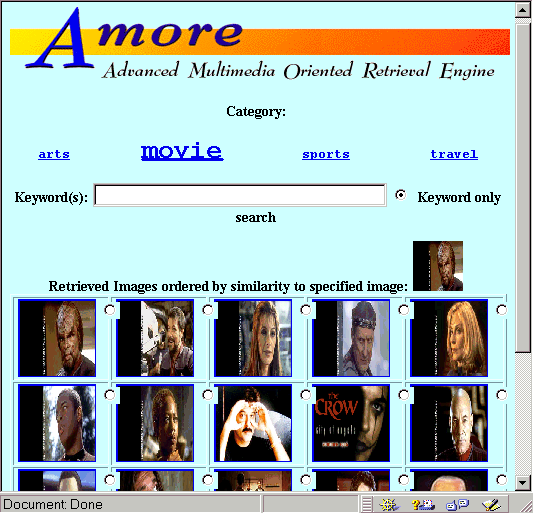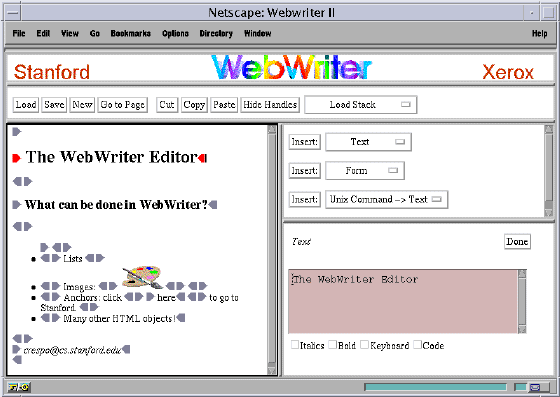Web Focus: Report on the WWW 6 Conference
The Sixth International World Wide Web Conference took place from 7-11th April 1997 in Santa Clara, California, USA. I attended the conference in my capacity as the JISC representative on the W3C (the World Wide Web Consortium).
About 1,800 people attended the conference. This figure was down on the last two years, due possibly to the close proximity of other conferences - the Javasoft conference attracted about 8,000 delagates and the Microsoft Hardware Engineering conference about 15,000 delegates. Both of these conference took place the week before the WWW 6 conference.
The main part of the conference took place from Tuesday, 8th April to Thursday, 10th April. Over these two days there were a number of Technical Sessions, covering themes such as Caching, Beyond HTML, Database Query Techniques and Usability Issues. In addition to the Technical Programme (which was based on refereed papers) there were also a number of Plenary Talks, Industrial Sessions, Business Presentations, W3C Presentations Collaborative Events and Birds of a Feather sessions.
On Tuesday, 7th April there were a number of half-day Tutorial and Workshop sessions. The conference Developer’s Day was held on Friday, 11th April. On the same day the first History Track took place.
Main Themes Of The Conference
XML
Two years ago the major talking point at the WWW conference was Java. This year Java seems to be accepted as the language for developing Web applications. The major new talking point was XML, the Extensible Markup Language.
XML has emerged from the SGML community as a lightweight version of SGML, designed for use on the network. Using XML information service providers, or even individual authors, can define the structure for their documents. Currently it is not possible using HTML to define a rich structure for an information resource. We do not have (and will not expect HTML to have) tags such as <STAFF-NUM>, <ISBN> or <LATITUDE>.
With XML it will be possible to define such elements. The definition of the elements (known as the DTD or Document Type Definition) can be sent along with the document. This is known as a valid XML document. An example is shown below:
<?XML version=“1.0” encoding=“UTF-8” ?> <!DOCTYPE greeting [ <!ELEMENT greeting (PCDATA)> ]> <greeting>Hello World!</greeting>
However the DTD does not have to be defined. The following is an example of a well-formed XML document.
<greeting>Hello World!</greeting>
Note that there are a number of rules which a well-formed XML document must satisfy, such as:
- All attribute values must be quoted e.g. <A HREF=“index.html”> and not <A HREF=index.html>
- Elements must contain a closing tag e.g.
<P>Notice the end paragraph tag</P>
and not
<P>The end paragraph tag is missing - Empty elements (elements which do not have an end tag) must be defined e.g.
<IMG SRC=“logo.gif”/>
As XML is an extensible markup language it can be used to define rich structures in documents. The big question, however, is how and whether browsers will support XML. As the XML FAQ says “with a few small changes an HTML browser like Netscape Navigator or Microsoft Internet Explorer would be able to read XML (the designers of XML would really like the authors of Navigator and Internet Explorer to make those changes)”.
Further information on XML is given in the XML FAQ [1] Cougar
Cougar is the codename for the next version of HTML. The Cougar specification [2] is due to be released in the summer. It contains a number of components, some of which have already been released:
- WD-htmllink [3] - which introduces the linking mechanisms for HTML and provides a few basic recommendations describing current practice, based upon discussions with search engine vendors.
- WD-style [4] - which extends HTML to provide support for style rules.
- WD-script [5] - which extends HTML to support locally executable scripts including JavaScript, VBScript, and other scripting languages.
- WD-frames [6] - which describes frame documents, the HTML syntax for frames, frame implementation notes, and includes a new proposal for extensions.
- WD-forms [7] - which describes proposed extensions for rich forms and interactive documents. Particular emphasis is placed upon access for people with disabilities.
- WD-object [8] - which extends HTML to support the insertion of multimedia objects including Java applets, Microsoft Component Object Model (COM) objects (e.g. ActiveX Controls and ActiveX Document embeddings), and a wide range of other media plug-ins.
- WD-entities [9] - which extends HTML to support additional named entities for all characters in ISO 8859-1, all characters representable by glyphs in the Adobe Symbol font, and entities required for Internationalisation
Unlike the HTML 3.0 specification, Cougar is being developed in conjunction with the major software vendors (including Microsoft, Netscape, Sun, IBM, etc.) Microsoft, in particular, were well represented at the WWW 6 conference and their presentation of Internet Explorer 4.0 in the Industrial Session emphasised their implementation of various aspects of Cougar.
Interesting Papers
There were several interesting papers presented at the conference. A brief summary of some of the papers presented insessions I attended is given below.
Towards An Advanced Multimedia Oriented Retrieval Engine
Sougata Mukherjea’s paper on “Towards An Advanced Multimedia Oriented Retrieval Engine” [10] will be of interest to developers of information gateways. The paper describes a search engine which can be used for searching for images, as shown in Figure 1.

Figure 1: The AMORE Interface
Responsive Interaction for a Large Web Application
Arturo Crespo’s talk on “Responsive Interaction for a Large Web Application” [10] describes WebWriter, an HTML authoring tool. WebWriter was initially developed as a server-based authoring tool, using a number of CGI scripts. WebWriterII makes use of Java to transfer some of the processing to the client. It will be interesting to see if applications such as this are developed to exploit the Document Object Model (DOM) for HTML, once browsers which support DOM become widely deployed.

Figure 2: The WebWriterII Interface
Transforming Command-Line Driven Systems to Web Applications
Constantinos Phanouriou’s paper on “Transforming Command-Line Driven Systems to Web Applications” [12] will interest programmers who have developed large applications which they wish to port to the Web. This paper was another example of a utility which had been written using Java.
Conference Proceedings
The proceedings for the WWW 6 conference are available on the Web [13]. Unfortunately, unlike the previous WWW conference, speakers slides were not made available in a central location.
As part of an online conference I will be hosting about the WWW 6 conference I have created a Web page which contains a number of trip reports and speakers’ slides [14].
References
- XML FAQ,
http://www.textuality.com/xml/faq.html - Cougar,
http://www.w3.org/pub/WWW/MarkUp/Cougar/ - WD-htmllink,
http://www.w3.org/pub/WWW/TR/WD-htmllink - WD-style,
http://www.w3.org/pub/WWW/TR/WD-htmllink - WD-script,
http://www.w3.org/pub/WWW/TR/WD-htmllink - WD-frames,
http://www.w3.org/pub/WWW/TR/WD-htmllink - WD-forms,
http://www.w3.org/pub/WWW/TR/WD-htmllink - WD-object,
http://www.w3.org/pub/WWW/TR/WD-htmllink - WD-entities,
http://www.w3.org/pub/WWW/TR/WD-htmllink - Towards An Advanced Multimedia Oriented Retrieval Engine,
http://www6.nttlabs.com/HyperNews/get/PAPER3.html - Responsive Interaction for a Large Web Application The Meteor Shower Architecture in the WebWriter II Editor,
http://www6.nttlabs.com/HyperNews/get/PAPER86.html - Transforming Command-Line Driven Systems to Web Applications,
http://www6.nttlabs.com/HyperNews/get/PAPER41.html - WWW 6 Conference Proceedings,
http://proceedings.www6conf.org/ - WWW 6 Trip Reports,
http://www.ukoln.ac.uk/groups/web-focus/events/conferences/www6/focus/
Author Details
Brian KellyUK Web Focus,
Email: B.Kelly@ukoln.ac.uk
Web Focus Web Site: http://www.ukoln.ac.uk/~lisbk/
Tel: 01225 826838
Address: UKOLN, University of Bath, Bath, BA2 7AY
